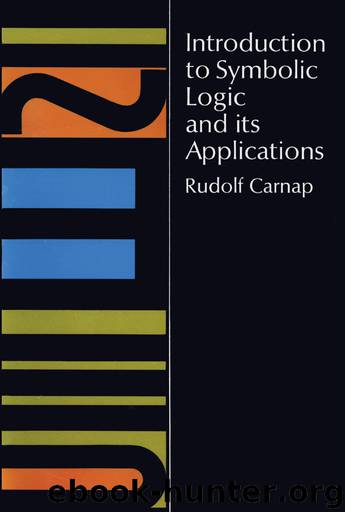Introduction to Symbolic Logic and Its Applications by Rudolf Carnap

Author:Rudolf Carnap
Language: eng
Format: epub
Publisher: Dover Publications, Inc.
Published: 1958-04-14T16:00:00+00:00
The identity principle P8 of language B (see 22a,b) is in accord with what has just been said. With its help e.g. ‘Pa⊃Pb’ is derivable from ‘a ≡ b’ on the one hand, and (by substituting ‘∼P’) ‘∼Pa⊃∼Pb’ on the other; from this last by transposition (cf. T8-6i(l)) comes ‘Pb⊃Pa’, which together with ‘Pa⊃Pb’ leads us to ‘Pa≡Pb’. Thus we see that it is adequate to phrase P8 with the conditional sign.
The following theorem tells us that identity is (totally) reflexive, symmetric and transitive.
+T29-1. Suppose , and are expressions of the type system; then a sentential formula having one of the following forms is L-true:
a. = .
b. = ⊃ ≡ .
c. ( = · = ) ⊃ = .
As earlier (see D17-1b), so here we write ‘≠’ for “non-identical”; in the present context, of course, ‘≠’ can stand between two expressions of any one type. Non-identity is frequently used when the word “two” appears in a verbal text. E.g. “For any two points, there are ...” is rendered ‘(x)(y)[Pt(xPt(y)·(x≠y) ⊃ (∃z)(...)]’.
Instances of the use of the identity sign between predicate expressions may be found in T29-3, T30-1, and D30-2; and of similar usage respecting functor expressions in 33c.
Sometimes we find it convenient to use ‘I’ as a conventional predicate designating identity, and similarly ‘J’ for non-identity—a practice that has proved advantageous in connection with other two-place predicates. Moreover, we can use ‘J3(a, b, c)’ as a compact way of saying that a,b and c are three different individuals; ‘J4’ can have a corresponding role respecting four arguments, etc.
D29-1. Ixy ≡ x=y.
D29-2. a. Jxy ≡ x≠y.
b. J3xyz ≡ (x≠y · x≠z · y≠z).
c. J4xyzu ≡ (x≠y · x≠z · x≠u · y≠z · y≠u · z≠u).
Download
This site does not store any files on its server. We only index and link to content provided by other sites. Please contact the content providers to delete copyright contents if any and email us, we'll remove relevant links or contents immediately.
| Algebra | Calculus |
| Combinatorics | Discrete Mathematics |
| Finite Mathematics | Fractals |
| Functional Analysis | Group Theory |
| Logic | Number Theory |
| Set Theory |
Modelling of Convective Heat and Mass Transfer in Rotating Flows by Igor V. Shevchuk(6391)
Weapons of Math Destruction by Cathy O'Neil(6148)
Factfulness: Ten Reasons We're Wrong About the World – and Why Things Are Better Than You Think by Hans Rosling(4694)
Descartes' Error by Antonio Damasio(3230)
A Mind For Numbers: How to Excel at Math and Science (Even If You Flunked Algebra) by Barbara Oakley(3221)
Factfulness_Ten Reasons We're Wrong About the World_and Why Things Are Better Than You Think by Hans Rosling(3199)
TCP IP by Todd Lammle(3134)
Fooled by Randomness: The Hidden Role of Chance in Life and in the Markets by Nassim Nicholas Taleb(3046)
Applied Predictive Modeling by Max Kuhn & Kjell Johnson(3019)
The Tyranny of Metrics by Jerry Z. Muller(3003)
The Book of Numbers by Peter Bentley(2912)
The Great Unknown by Marcus du Sautoy(2648)
Once Upon an Algorithm by Martin Erwig(2599)
Easy Algebra Step-by-Step by Sandra Luna McCune(2585)
Lady Luck by Kristen Ashley(2534)
Practical Guide To Principal Component Methods in R (Multivariate Analysis Book 2) by Alboukadel Kassambara(2497)
Police Exams Prep 2018-2019 by Kaplan Test Prep(2487)
All Things Reconsidered by Bill Thompson III(2357)
Linear Time-Invariant Systems, Behaviors and Modules by Ulrich Oberst & Martin Scheicher & Ingrid Scheicher(2334)
